Mapping Energy Poverty: How Much Impact Do Socioeconomic, Urban and Climatic Variables Have at a Territorial Scale?
Abstract
:1. Introduction
1.1. Energy Poverty Conceptualisations for a Developing Context
1.2. The Territorial Scale in the Study of Energy Poverty
2. Methodology
2.1. Study Design
2.2. Methodological Limitations
2.3. Case Study and Data
- Socio-Material Territorial Indicator (SMTI): a supra-variable that is constructed from four census indicators with territorial specificity: head of household education index, housing material quality index, overcrowding index, and doubled-up household index [76]. It is important to note that in Chile, the income variable only exists in the CASEN survey (“National Socioeconomic Characterization” in Spanish), which is not representative at detailed scales (regional, city and, in some cases, commune). Due to this, proxy indicators, such as the SMTI, have been historically used to represent socioeconomic conditions.
- The diversity of land uses is defined through the Shannon index. This indicator measures variety, in this case of land use, contrasting proportional uses for a given spatial unit. A value close to −2 indicates more significant use heterogeneity, typical of centralities and sub-centralities. When the indicator is close to 0, only one land-use type usually corresponds to residential areas.
- Land price values
- Percentage of professionals, according to the general categories of the International Standard Classification of Occupation (ISCO) [77].
- Demographic indicators, such as households with and without children.
- Average year of construction.
- Indicator of housing material quality.
- Land surface temperature (LST).
- Annual thermal amplitude is the difference between the maximum and minimum temperatures in a year and is obtained according to satellite imagery.
- According to satellite imagery, the normalized difference vegetation index (NDVI) indicates total green areas (public and private).
- Urban segregation is defined according to the Theil index. This indicator calculates entropy as a measure of segregation [78], in this case, considering the internal proportion of the census tracts according to the value of the SMTI (socioeconomic proxy indicator) and weighting it with the comparison between the census tracts and their contiguous zones (topological matrix of spatial weights).
- Percentage of houses vs flats in new projects.
- Regulatory indicators include occupancy coefficients, construction indices, and maximum heights.
3. Results
3.1. Model Selection
3.2. Interpretation: Spatial Patterns of Energy Poverty in the Metropolitan Area of Santiago de Chile
- Eastern Area: in Santiago’s metropolitan area, the higher income sectors are concentrated in “a sort of triangle that has one of its vertices in the commune of Santiago and then stretches towards the northeast, covering a good part of the mountain slopes” [79]. The so-called “high-income cone” [80] has been characterized by processes of spatial self-segregation [81]. In the model, it is expressed with a defined pattern to the dependent variable. Here, there are high inside temperatures transversal to the communes that compose it (Ñuñoa, La Reina, Providencia, Las Condes, Vitacura, and Lo Barnechea). Specifically, the highest values occur in the eastern boundary of the commune of Santiago, the northeastern zone of Ñuñoa, west of La Reina, the vast majority of Providencia and Las Condes, the western sector of Lo Barnechea, and uniformly for the entire commune of Vitacura (Figure 3). The general pattern is reinforced with the four variables of the model. Still, specifically for the highest temperatures, the variables that operate at the local level are the material of the home together with the annual thermal amplitude. This situation is evident when observing the agglomeration of high-temperature sectors in Santiago, which also coincides with the higher percentages of professionals and a greater vegetation cover and green areas expressed in the NDVI (Figure 5). In terms of standardized residuals, the most overestimated place is the foothills of this high-income cone (expressed through lower temperatures in winter), where the geographical factor prevails. The opposite case occurs in some vulnerable enclaves of these communes where the percentage of professionals decreases as well as the material quality of the homes. Still, the other environmental variables remain constant, causing the model to underestimate the observations.
- Pericentral area: in the communes surrounding the center of the metropolitan area of Santiago (Recoleta, Independencia, Quinta Normal, Estación Central and Pedro Aguirre Cerda), there is a pattern of lower temperatures inside the homes in winter compared to the center of the consolidated urban area (Figure 3). Two independent variables mainly explain this: (1) the material quality of the housing is generally precarious, associated in many cases with self-construction processes. This is also reinforced with the second variable that, in this case, corresponds to the almost zero presence of vegetation detected by the (2) NDVI indicator, a situation that is not only expressed as access to public green areas but also more strongly as lack of public trees and private vegetation (inside the home.) The exceptions for this spatial pattern are expressed by the values overestimated by the model (higher temperatures) for part of the commune of San Miguel (neighborhood known as the Llano Subercaseaux) given its higher socioeconomic nature and the better-quality housing material. This is because they are homes built with recent regulations, an urban renewal sector in the verticalization process. The second milestone is the area around the Quinta Normal urban park—a situation associated in this case with the presence of vegetation—which should help mitigate temperatures, which does not occur as the model predicted.
- Northern area: the pattern of inside temperatures of the homes is slightly higher than expected, given the characteristics of the socioeconomic vulnerability of the area, combined with a low presence of vegetation and low material quality indices of the home (Figure 5). This is mainly explained by the behavior of the thermal amplitude, which determines the model in this extensive area of the metropolitan area of Santiago (communes of Lo Prado, Cerro Navia, Renca, and Quilicura). The values of thermal amplitude are the highest, which translates into higher maximum temperatures in summer. However, slightly higher minimum temperatures are also observed in winter, which defines an extensive pattern of inside temperatures in homes somewhat higher than the rest of the peripheral areas (but in this case, not due to housing material).
- Southern area: In terms of the dependent variable, the lowest temperature values inside the homes during the winter occur in the communes of Maipú, Lo Espejo, San Ramón, La Granja, La Florida, San Bernardo, La Pintana, and Puente Alto (Figure 3). In this case, the lowest values of the four independent variables are combined to justify the values observed and estimated by the geographically weighted regression model, with extreme cases in particularly vulnerable areas, such as the Bajo de Mena sector, south of the commune of Puente Alto.
3.3. Validation of the Model
4. Discussion
5. Conclusions
Author Contributions
Funding
Institutional Review Board Statement
Data Availability Statement
Acknowledgments
Conflicts of Interest
References
- Kerr, N.; Gillard, R.; Middlemiss, L. Politics, Problematisation, and Policy: A Comparative Analysis of Energy Poverty in England, Ireland and France. Energy Build. 2019, 194, 191–200. [Google Scholar] [CrossRef]
- Primc, K.; Slabe-Erker, R.; Majcen, B. Constructing Energy Poverty Profiles for an Effective Energy Policy. Energy Policy 2019, 128, 727–734. [Google Scholar] [CrossRef]
- Walker, G.; Day, R. Fuel Poverty as Injustice: Integrating Distribution, Recognition and Procedure in the Struggle for Affordable Warmth. Energy Policy 2012, 49, 69–75. [Google Scholar] [CrossRef]
- Hills, J. Getting the Measure of Fuel Poverty: Final Report of the Fuel Poverty Review. CASE Report 72; Centre for Analysis of Social Exclusion, The London School of Economics and Political Science: London, UK, 2012. [Google Scholar]
- Boardman, B. Fuel Poverty: From Cold Homes to Affordable Warmth; Wiley and Sons: London, UK, 1991. [Google Scholar]
- Liddell, C. Fuel Poverty Comes of Age: Commemorating 21 Years of Research and Policy. Energy Policy 2012, 49, 2–5. [Google Scholar] [CrossRef]
- Rademaekers, K.; Yearwood, J.; Ferreira, A.; Pye, S.; Hamilton, I.; Agnolucci, P.; Grover, D.; Karásek, J.; Animisova, N. Selecting Indicators to Measure Energy Poverty; Trinomics, B.V.: Rotterdam, The Netherlands, 2016. [Google Scholar]
- Moore, R. Definitions of Fuel Poverty: Implications for Policy. Energy Policy 2012, 49, 19–26. [Google Scholar] [CrossRef]
- Boardman, B. Fixing Fuel Poverty: Challenges and Solutions; Earthscan: London, UK, 2010. [Google Scholar]
- González-Eguino, M. Energy Poverty: An Overview. Renew. Sustain. Energy Rev. 2015, 47, 377–385. [Google Scholar] [CrossRef]
- Calvo, R.; Amigo, C.; Billi, M.; Cortés, A.; Mendoza, P.; Tapia, R.; Urquieta, M.A.; Urquiza, A. Acceso Equitativo a Energía de Calidad en Chile: Hacia un Indicador Territorializado y Tridimensional de Pobreza Energética; Red de Pobreza Energética: Santiago, Chile, 2019; ISBN 978-956-398-826-0. [Google Scholar]
- United Nations. Transforming Our World: The 2030 Agenda for Sustainable Development; United Nations: New York, NY, USA, 2015. [Google Scholar]
- Ministerio de Energía. Transición Energética de Chile. Política Energética Nacional. Actualización 2022; Ministerio de Energía: Santiago, Chile, 2022.
- Bridge, B.A.; Adhikari, D.; Fontenla, M. Electricity, Income, and Quality of Life. Soc. Sci. J. 2016, 53, 33–39. [Google Scholar] [CrossRef]
- Vilches, A.; Barrios Padura, Á.; Molina Huelva, M. Retrofitting of Homes for People in Fuel Poverty: Approach Based on Household Thermal Comfort. Energy Policy 2017, 100, 283–291. [Google Scholar] [CrossRef]
- Igawa, M.; Managi, S. Energy Poverty and Income Inequality: An Economic Analysis of 37 Countries. Appl. Energy 2022, 306, 118076. [Google Scholar] [CrossRef]
- Bouzarovski, S. Energy Poverty in the European Union: Landscapes of Vulnerability. Wiley Interdiscip. Rev. Energy Environ. 2014, 3, 276–289. [Google Scholar] [CrossRef]
- Buzar, S. Energy Poverty in Eastern Europe: Hidden Geographies of Deprivation; Routledge: Boca Raton, FL, USA, 2007. [Google Scholar]
- Primc, K.; Slabe-Erker, R.; Majcen, B. Energy Poverty: A Macrolevel Perspective. Sustain. Dev. 2019, 27, 982–989. [Google Scholar] [CrossRef]
- Hidalgo, R.; Borsdorf, A.; Zunino, H.M.; Álvarez, L. Tipologías de Expansión Metropolitana En Santiago de Chile: Precariópolis Estatal y Privatópolis Inmobiliaria. Scr. Nova Rev. Electrónica Geogr. Cienc. Soc. 2008, 12, 113. [Google Scholar]
- Kocak, E.; Baglitas, H.H. The Path to Sustainable Municipal Solid Waste Management: Do Human Development, Energy Efficiency, and Income Inequality Matter? Sustain. Dev. 2022, 1–16. [Google Scholar] [CrossRef]
- Guzmán-Rosas, S.C. Ethnicity as a Social Determinant of Energy Poverty: The Case of Mexican Indigenous Population. Local Environ. 2022, 27, 1075–1101. [Google Scholar] [CrossRef]
- Caprotti, F.; de Groot, J.; Bobbins, K.; Mathebula, N.; Butler, C.; Moorlach, M.; Schloemann, H.; Densmore, A.; Finlay, K. Rethinking the Off-Grid City. Urban Geogr. 2022, 1–14. [Google Scholar] [CrossRef]
- Croce, S.; Tondini, S. Fixed and Mobile Low-Cost Sensing Approaches for Microclimate Monitoring in Urban Areas: A Preliminary Study in the City of Bolzano (Italy). Smart Cities 2022, 5, 54–70. [Google Scholar] [CrossRef]
- Bouzarovski, S. Just Transitions: A Political Ecology Critique. Antipode 2022, 54, 1003–1020. [Google Scholar] [CrossRef]
- Alabi, O.; Abubakar, A.; Werkmeister, A.; Sule, S.D. Keeping the Lights On or Off: Tracking the Progress of Access to Electricity for Sustainable Development in Nigeria. GeoJournal 2022, 1–24. [Google Scholar] [CrossRef]
- Munro, P.G.; Samarakoon, S. Off-Grid Electrical Urbanism: Emerging Solar Energy Geographies in Ordinary Cities. J. Urban Technol. 2022, 1–24. [Google Scholar] [CrossRef]
- Chipango, E.F. Political Ecologies of Energy Poverty in Zimbabwe. GeoJournal 2022, 1–15. [Google Scholar] [CrossRef]
- Bîrsănuc, E.-M. Mapping Gendered Vulnerability to Energy Poverty in Romania. Appl. Spat. Anal. Policy 2022, 1–20. [Google Scholar] [CrossRef]
- Bouzarovski, S.; Simcock, N. Spatializing Energy Justice. Energy Policy 2017, 107, 640–648. [Google Scholar] [CrossRef]
- März, S. Assessing the Fuel Poverty Vulnerability of Urban Neighbourhoods Using a Spatial Multi-Criteria Decision Analysis for the German City of Oberhausen. Renew. Sustain. Energy Rev. 2018, 82, 1701–1711. [Google Scholar] [CrossRef]
- Robinson, C.; Lindley, S.; Bouzarovski, S. The Spatially Varying Components of Vulnerability to Energy Poverty. Ann. Am. Assoc. Geogr. 2019, 109, 1188–1207. [Google Scholar] [CrossRef]
- Reames, T.G. Targeting Energy Justice: Exploring Spatial, Racial/Ethnic and Socioeconomic Disparities in Urban Residential Heating Energy Efficiency. Energy Policy 2016, 97, 549–558. [Google Scholar] [CrossRef]
- Scarpellini, S.; Sanz Hernández, M.A.; Moneva, J.M.; Portillo-Tarragona, P.; López Rodríguez, M.E. Measurement of Spatial Socioeconomic Impact of Energy Poverty. Energy Policy 2019, 124, 320–331. [Google Scholar] [CrossRef]
- López-Bueno, J.A.; Díaz, J.; Sánchez-Guevara, C.; Sánchez-Martínez, G.; Franco, M.; Gullón, P.; Núñez Peiró, M.; Valero, I.; Linares, C. The Impact of Heat Waves on Daily Mortality in Districts in Madrid: The Effect of Sociodemographic Factors. Environ. Res. 2020, 190, 109993. [Google Scholar] [CrossRef]
- Martín-Consuegra, F.; Hernández-Aja, A.; Oteiza, I.; Alonso, C. Distribución de La Pobreza Energética En La Ciudad de Madrid (España). EURE-Rev. Estud. Urbano Reg. 2019, 45, 133–152. [Google Scholar] [CrossRef]
- Sanusi, Y.A.; Owoyele, G.S. Energy Poverty and Its Spatial Differences in Nigeria: Reversing the Trend. Energy Procedia 2016, 93, 53–60. [Google Scholar] [CrossRef]
- Gupta, S.; Gupta, E.; Sarangi, G.K. Household Energy Poverty Index for India: An Analysis of Inter-State Differences. Energy Policy 2020, 144, 111592. [Google Scholar] [CrossRef]
- Marchand, R.; Genovese, A.; Koh, S.C.L.; Brennan, A. Examining the Relationship between Energy Poverty and Measures of Deprivation. Energy Policy 2019, 130, 206–217. [Google Scholar] [CrossRef]
- Moore, D.; Webb, A.L. Evaluating Energy Burden at the Urban Scale: A Spatial Regression Approach in Cincinnati, Ohio. Energy Policy 2022, 160, 112651. [Google Scholar] [CrossRef]
- García-Ochoa, R.; Graizbord, B. Privation of Energy Services in Mexican Households: An Alternative Measure of Energy Poverty. Energy Res. Soc. Sci. 2016, 18, 36–49. [Google Scholar] [CrossRef]
- Pérez-Fargallo, A.; Bienvenido-Huertas, D.; Rubio-Bellido, C.; Trebilcock, M. Energy Poverty Risk Mapping Methodology Considering the User’s Thermal Adaptability: The Case of Chile. Energy Sustain. Dev. 2020, 58, 63–77. [Google Scholar] [CrossRef]
- Chen, H.-C.; Han, Q.; de Vries, B. Modeling the Spatial Relation between Urban Morphology, Land Surface Temperature and Urban Energy Demand. Sustain. Cities Soc. 2020, 60, 102246. [Google Scholar] [CrossRef]
- Meng, Y.; Xing, H.; Yuan, Y.; Wong, M.S.; Fan, K. Sensing Urban Poverty: From the Perspective of Human Perception-Based Greenery and Open-Space Landscapes. Comput. Environ. Urban Syst. 2020, 84, 101544. [Google Scholar] [CrossRef]
- Shaker, R.R.; Altman, Y.; Deng, C.; Vaz, E.; Forsythe, K.W. Investigating Urban Heat Island through Spatial Analysis of New York City Streetscapes. J. Clean. Prod. 2019, 233, 972–992. [Google Scholar] [CrossRef]
- Tu, M.; Liu, Z.; He, C.; Fang, Z.; Lu, W. The Relationships between Urban Landscape Patterns and Fine Particulate Pollution in China: A Multiscale Investigation Using a Geographically Weighted Regression Model. J. Clean. Prod. 2019, 237, 117744. [Google Scholar] [CrossRef]
- Robinson, C.; Bouzarovski, S.; Lindley, S. Underrepresenting Neighbourhood Vulnerabilities? The Measurement of Fuel Poverty in England. Environ. Plan. A Econ. Space 2018, 50, 1109–1127. [Google Scholar] [CrossRef]
- O’Sullivan, D. Geographically Weighted Regression: The Analysis of Spatially Varying Relationships (Review). Geogr. Anal. 2010, 35, 272–275. [Google Scholar] [CrossRef]
- Páez, A.; Farber, S.; Wheeler, D. A Simulation-Based Study of Geographically Weighted Regression as a Method for Investigating Spatially Varying Relationships. Environ. Plan. A Econ. Space 2011, 43, 2992–3010. [Google Scholar] [CrossRef]
- Griffith, D.A. A Linear Regression Solution to the Spatial Autocorrelation Problem. J. Geogr. Syst. 2000, 2, 141–156. [Google Scholar] [CrossRef]
- Sánchez-Peña, L.L. Alcances y Límites de Los Métodos de Análisis Espacial Para El Estudio de La Pobreza Urbana. Pap. Población 2012, 18, 147–180. [Google Scholar]
- INE; MINVU. Metodología Para Medir el Crecimiento Urbano de Las Ciudades de Chile; Ministerio de Vivienda y Urbanismo: Santiago, Chile, 2017.
- Vergara-Perucich, J.F. Aplicaciones de La Teoría Implosión/Explosión: Relación Entre La Región Metropolitana de Santiago de Chile y Los Territorios Productivos Regionales. EURE-Rev. Estud. Urbano Reg. 2018, 44, 71–90. [Google Scholar] [CrossRef]
- Celedon Forster, A. Operación Piloto: Santiago En Tres Actos. Revista 180 2019, 43, 1–12. [Google Scholar] [CrossRef]
- Gross, P. Santiago de Chile (1925–1990): Planificación Urbana y Modelos Políticos. EURE-Rev. Estud. Urbano Reg. 1991, 17, 27–52. [Google Scholar]
- Vergara-Perucich, F.; Boano, C. The Big Bang of Neoliberal Urbanism: The Gigantomachy of Santiago’s Urban Development. Environ. Plan. C Politics Space 2021, 39, 184–203. [Google Scholar] [CrossRef]
- Garreton, M. City Profile: Actually Existing Neoliberalism in Greater Santiago. Cities 2017, 65, 32–50. [Google Scholar] [CrossRef]
- Donoso, F.; Sabatini, F. Santiago: Empresa Inmobiliaria Compra Terrenos. EURE-Rev. Estud. Urbano Reg. 1980, 7, 25–51. [Google Scholar]
- Trivelli, P. Accesibilidad al Suelo Urbano y La Vivienda Por Parte de Los Sectores de Menos Ingresos En América Latina. EURE-Rev. Estud. Urbano Reg. 1982, 9, 7–32. [Google Scholar]
- Sabatini, F.; Brain, I. La Segregación, Los Guetos y La Integración Social Urbana: Mitos y Claves. EURE-Rev. Estud. Urbano Reg. 2008, 34, 5–26. [Google Scholar] [CrossRef]
- Hidalgo, R. ¿Se Acabo El Suelo En La Gran Ciudad? Las Nuevas Periferias Metropolitanas de La Vivienda Social En Santiago de Chile. EURE-Rev. Estud. Urbano Reg. 2007, 33, 57–75. [Google Scholar] [CrossRef]
- Encinas, F.; Aguirre, C.; Vergara-Perucich, F.; Tironi, M.; Truffello, R.; Freed, C.; Hidalgo, R. Disciplinary Inflections: Contesting Three Concepts for the Construction of the Post-Neoliberal City. ARQ 2021, 107, 46–57. [Google Scholar] [CrossRef]
- Vergara-Perucich, F.; Aguirre, C.; Encinas, F.; Truffello, R.; Ladrón de Guevara, F. Contribución a la Economía Política de la Vivienda en Chile; RiL Editores: Santiago, Chile, 2020. [Google Scholar]
- Sarricolea Espinoza, P.; Martín-Vide, J. El Estudio de La Isla de Calor Urbana de Superficie Del Área Metropolitana de Santiago de Chile Con Imágenes Terra-MODIS y Análisis de Componentes Principales. Rev. Geogr. Norte Gd. 2014, 123–141. [Google Scholar] [CrossRef]
- Montaner-Fernández, D.; Morales-Salinas, L.; Rodriguez, J.S.; Cárdenas-Jirón, L.; Huete, A.; Fuentes-Jaque, G.; Pérez-Martínez, W.; Cabezas, J. Spatio-Temporal Variation of the Urban Heat Island in Santiago, Chile during Summers 2005–2017. Remote Sens. 2020, 12, 3345. [Google Scholar] [CrossRef]
- Romero, H.; Vásquez, A.; Fuentes, C.; Salgado, M.; Schmidt, A.; Banzhaf, E. Assessing Urban Environmental Segregation (UES). The Case of Santiago de Chile. Ecol. Indic. 2012, 23, 76–87. [Google Scholar] [CrossRef]
- Calvo, R.; Amigo, C.; Billi, M.; Fleischmann, M.; Urquiza, A. Vulnerabilidad Energética Territorial: Desigualdad Mas Allá del Hogar; Red de Pobreza Energética: Santiago, Chile, 2020; ISBN 978-956-402-385-4. [Google Scholar]
- MINVU RENAM-Red Nacional de Monitoreo. Available online: https://renam.cl (accessed on 20 July 2022).
- González, K.; Amigo, C.; Calvo, R.; Oyarzún, T.; San Martín, M.; Urquiza, A.; Álvarez, M.; Hidalgo, F.; Muñoz, F.; Tapia, T.; et al. Una Mirada Multidimensional a la Pobreza Energética en Chile; Red de Pobreza Energética and Generadoras de Chile: Santiago, Chile, 2022. [Google Scholar]
- Becerra, M.; Jerez, A.; Valenzuela, M.; Garcés, H.O.; Demarco, R. Life Quality Disparity: Analysis of Indoor Comfort Gaps for Chilean Households. Energy Policy 2018, 121, 190–201. [Google Scholar] [CrossRef]
- Castaño-Rosa, R.; Solís-Guzmán, J.; Rubio-Bellido, C.; Marrero, M. Towards a Multiple-Indicator Approach to Energy Poverty in the European Union: A Review. Energy Build. 2019, 193, 36–48. [Google Scholar] [CrossRef]
- Urquiza, A.; Amigo, C.; Billi, M.; Leal, T. Pobreza Energética en Chile: ¿Un Problema Invisible? Análisis de Fuentes Secundarias Disponibles de Alcance Nacional; Red de Pobreza Energética, Universidad de Chile: Santiago, Chile, 2017. [Google Scholar]
- OCUC. Observatorio de Ciudades UC. Centro de Investigación Urbano-Territorial. Available online: https://observatoriodeciudades.com (accessed on 20 July 2022).
- CENSO. 2017 Microdatos Censo. 2017. Available online: http://www.censo2017.cl/microdatos/ (accessed on 20 July 2022).
- USGS. Landsat 8. Available online: https://earthexplorer.usgs.gov (accessed on 20 July 2022).
- Encinas, F.; Truffello, R.; Aguirre, C.; Hidalgo, R. Speculation, Land Rent, and the Neoliberal City. Or Why Free Market Is Not Enough. ARQ 2019, 120–133. [Google Scholar] [CrossRef]
- OIT. Clasificación Internacional Uniforme de Ocupaciones; International Labour Office: Geneva, Switzerland, 2008. [Google Scholar]
- Parisi, D.; Lichter, D.T.; Taquino, M.C. Multi-Scale Residential Segregation: Black Exceptionalism and America’s Changing Color Line. Soc. Forces 2011, 89, 829–852. [Google Scholar] [CrossRef]
- De Mattos, C.A. Mercado Metropolitano de Trabajo y Desigualdades Sociales En El Gran Santiago: ¿Una Ciudad Dual? EURE-Rev. Estud. Urbano Reg. 2002, 28, 51–70. [Google Scholar] [CrossRef]
- Link, F.; Valenzuela, F.; Fuentes, L. Segregación, Estructura y Composición Social Del Territorio Metropolitano En Santiago de Chile: Complejidades Metodológicas En El Análisis de La Diferenciación Social En El Espacio. Rev. Geogr. Norte Gd. 2015, 28, 151–168. [Google Scholar] [CrossRef]
- Sabatini, F.; Cáceres, G.; Cerda, J. Segregación Residencial En Las Principales Ciudades Chilenas: Tendencias de Las Tres Últimas Décadas y Posiblescursos de Acción. EURE-Rev. Estud. Urbano Reg. 2001, 27, 21–42. [Google Scholar] [CrossRef]
- Griffith, D.A. Effective Geographic Sample Size in the Presence of Spatial Autocorrelation. Ann. Assoc. Am. Geogr. 2005, 95, 740–760. [Google Scholar] [CrossRef]
- She, B.; Duque, J.C.; Ye, X. The Network-Max-P-Regions Model. Int. J. Geogr. Inf. Sci. 2017, 31, 962–981. [Google Scholar] [CrossRef]
- Folch, D.C.; Spielman, S.E. Identifying Regions Based on Flexible User-Defined Constraints. Int. J. Geogr. Inf. Sci. 2014, 28, 164–184. [Google Scholar] [CrossRef]
- Rodríguez-iglesias, G.; Teresa, M. La importancia de la especificidad territorial en la construccion de indicadores locales. Cienc. Ergo Sum 2010, 18, 145–152. [Google Scholar]
- Fuentes, V.; Montecinos, E.; Güell, P. (Eds.) El Nuevo Orden Regional: Construcción Social y Gobernanza del Territorio; Ediciones UACh: Valdivia, Chile, 2020; ISBN 978-956-390-116-0. [Google Scholar]
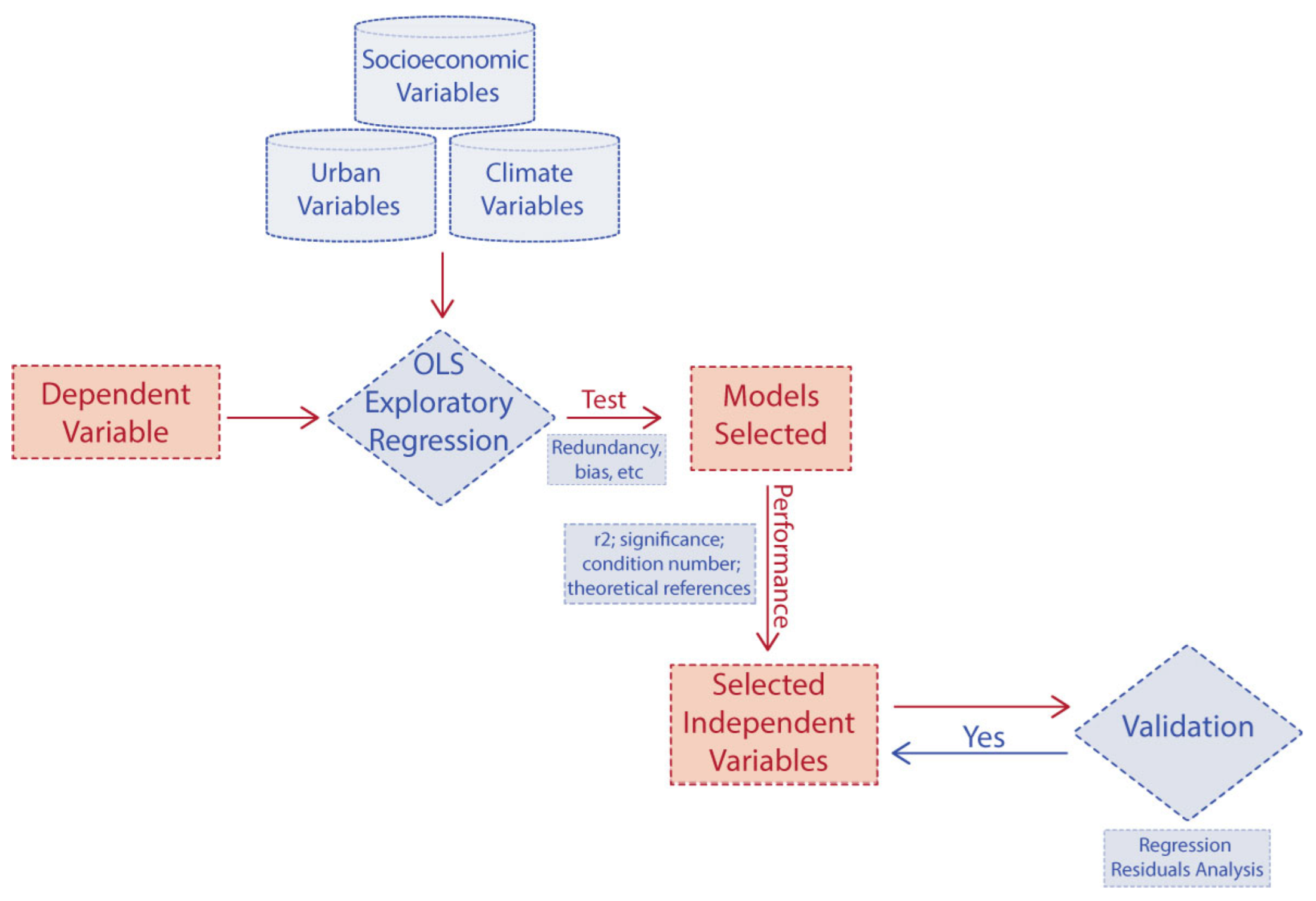
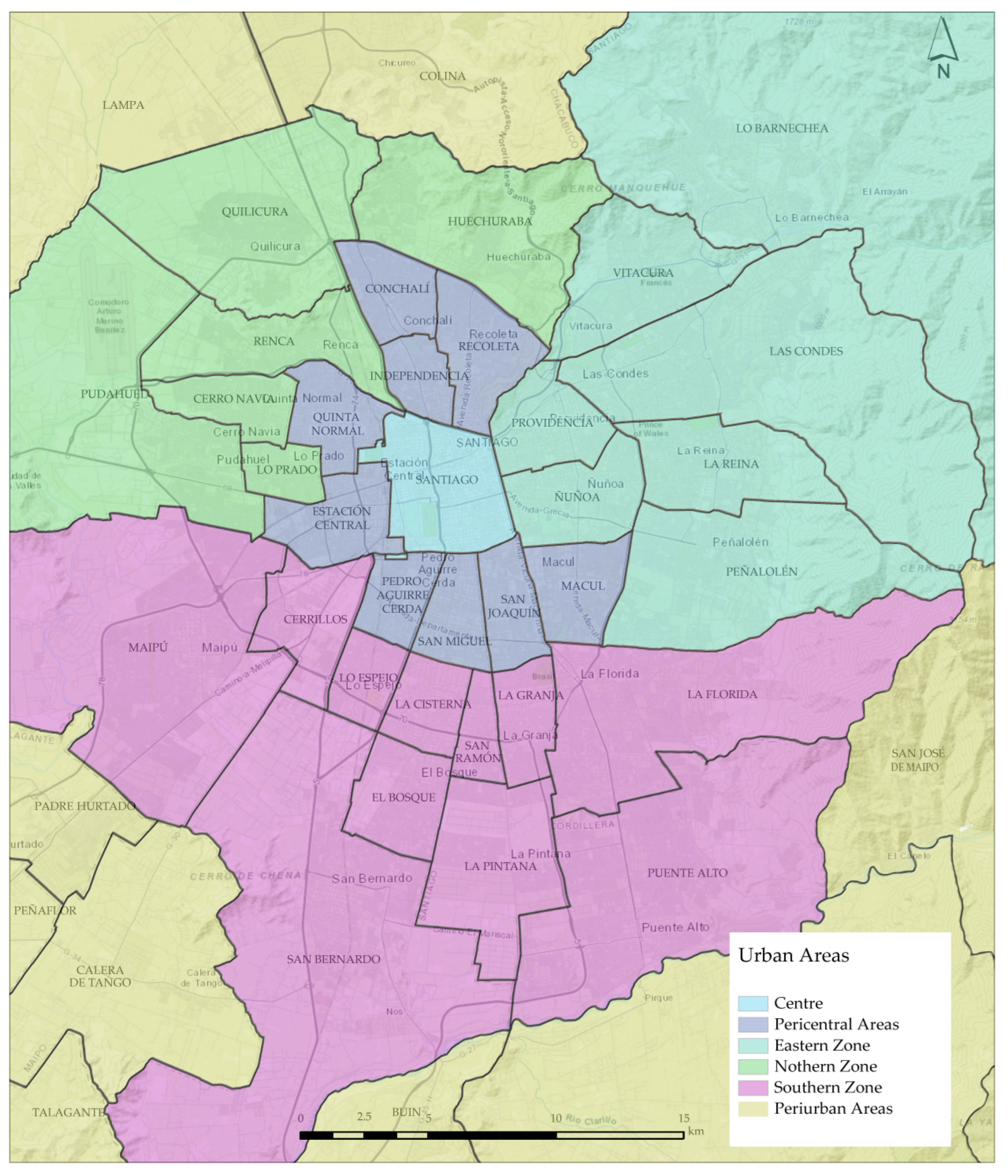
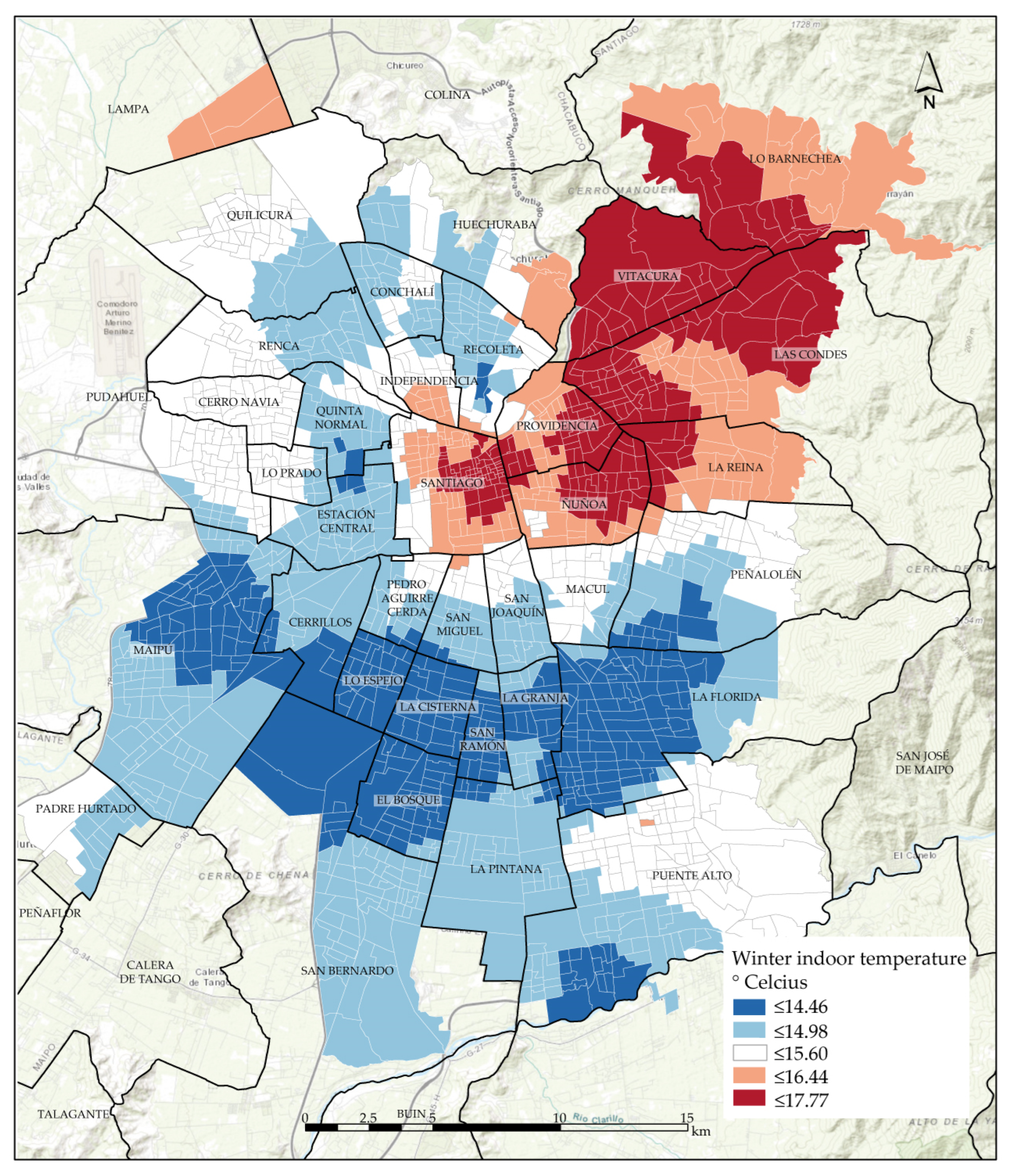

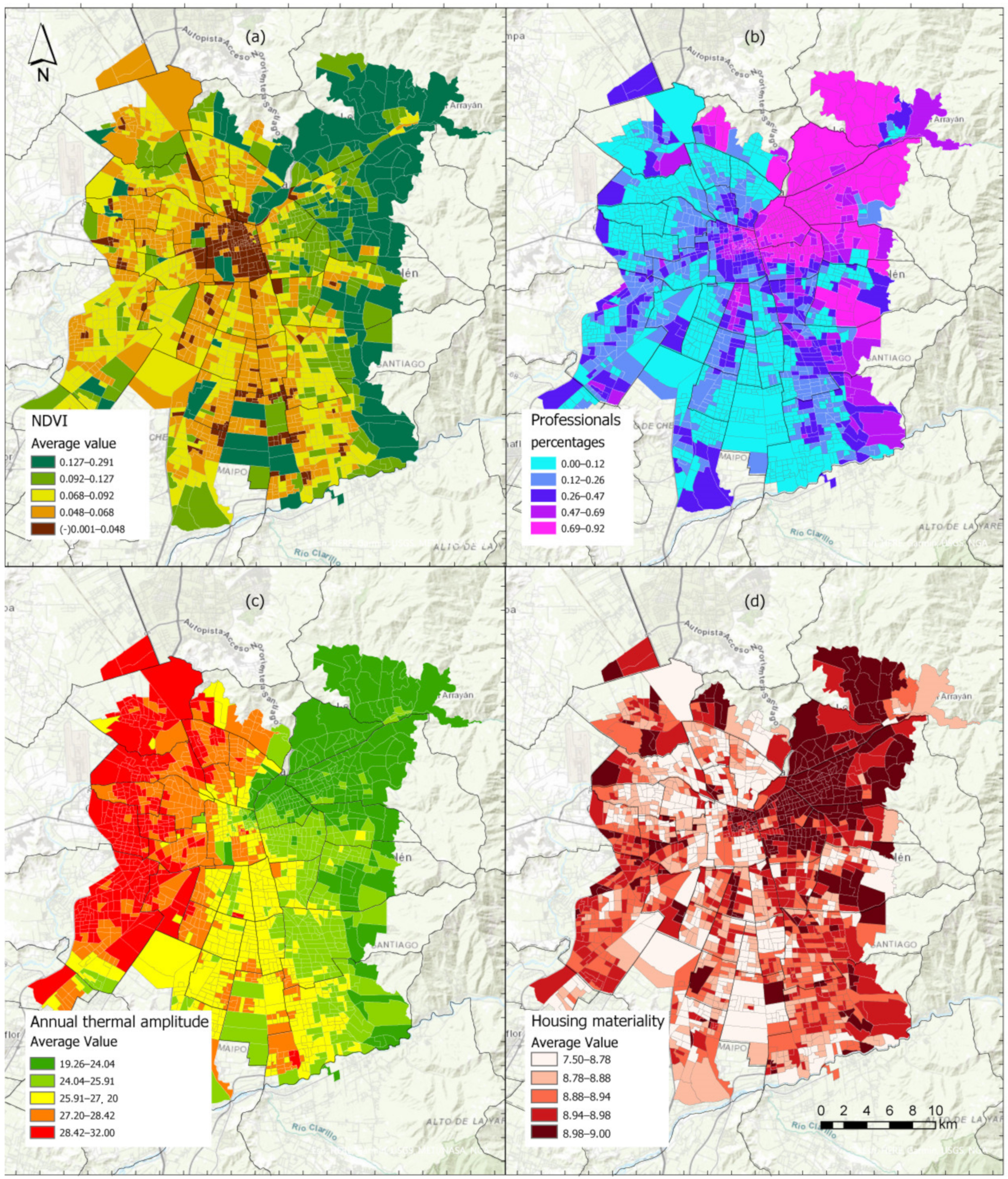
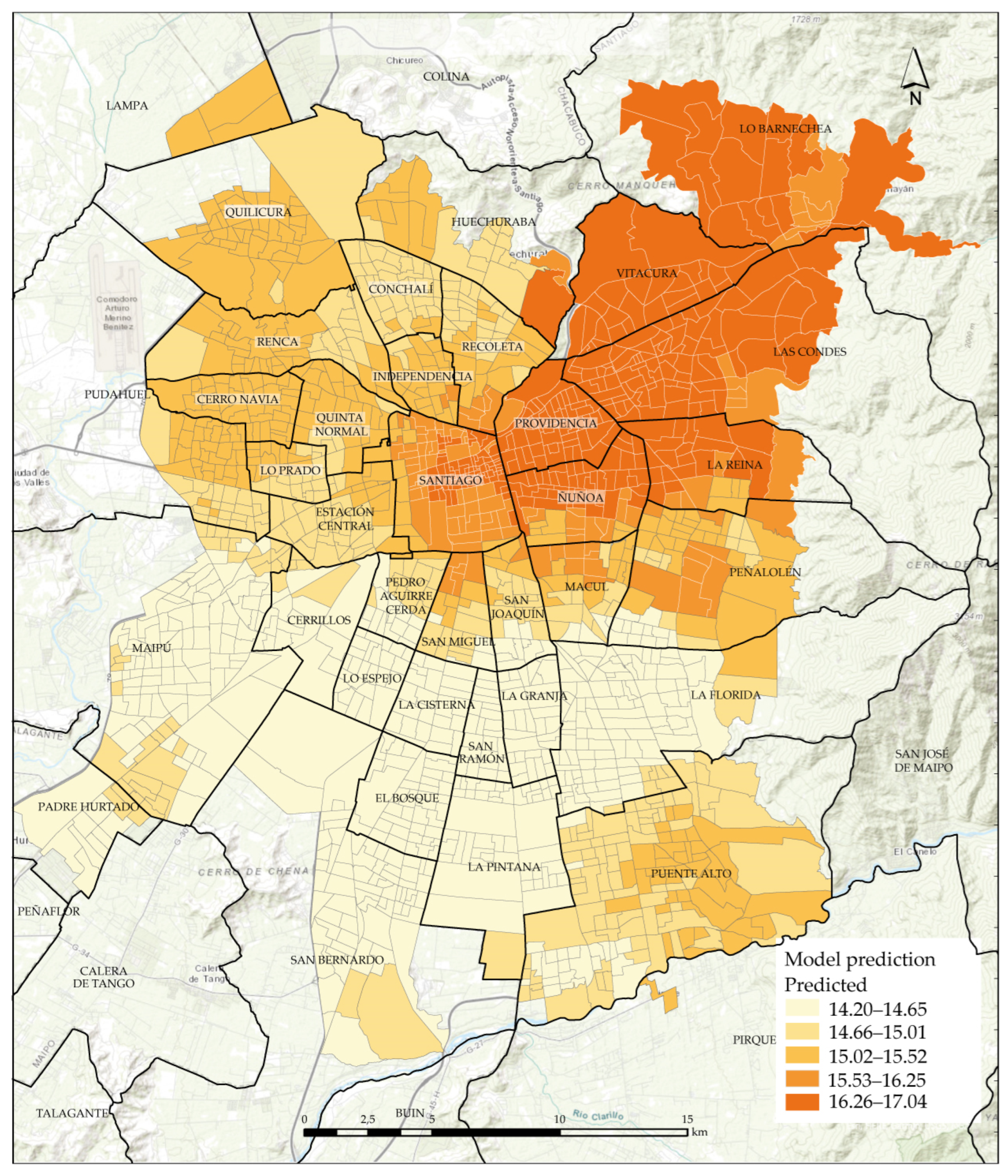
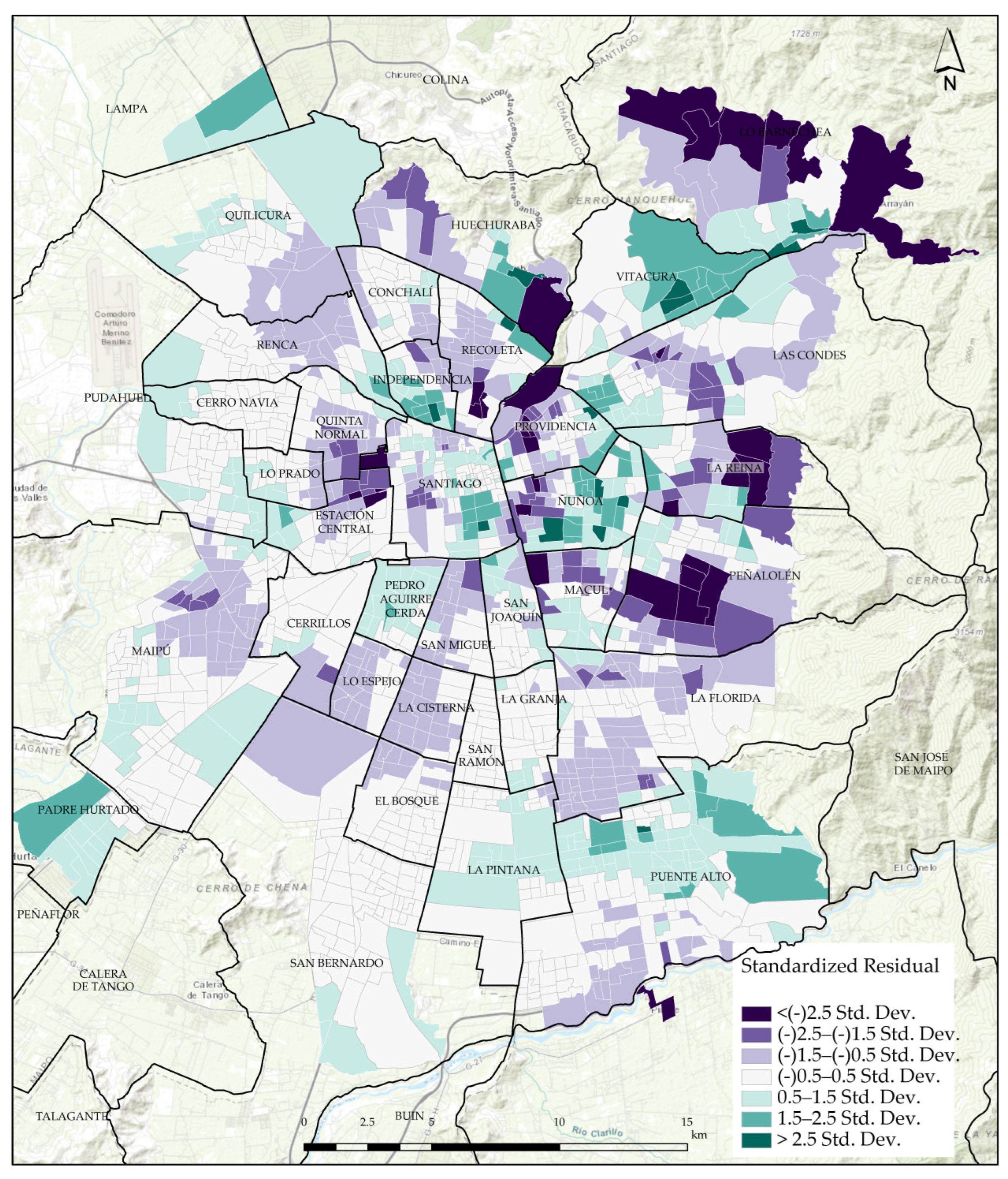

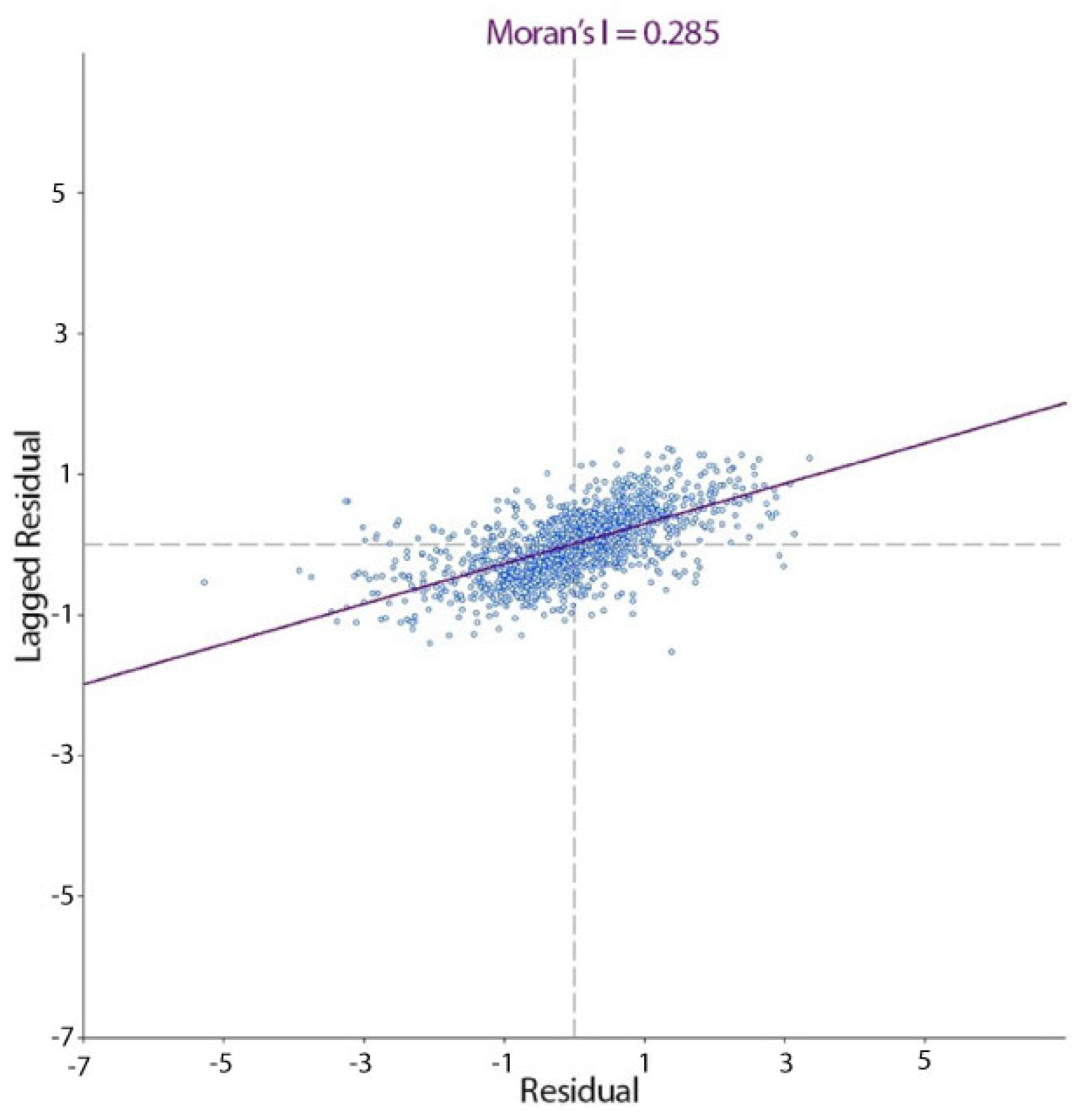

| Search Criteria | Cut-Off | Attempts | Successes | Percentage of Correct Answers |
|---|---|---|---|---|
| R2 minimum | >0.4 | 637 | 487 | 76.5% |
| p-Value | <0.05 | 637 | 379 | 59.5% |
| VIF Value | <7.50 | 637 | 637 | 100% |
| Jarque–Bera p-value | >0.10 | 637 | 11 | 1.7% |
| Model 1 | Model 2 | Model 3 | Model 4 | |
|---|---|---|---|---|
| Dependent variable | Inside temperature of homes in winter (year 2017) | |||
| Independent variables | NDVI | Professional percentage | Professional percentage | Professional percentage |
| Land price | Land price | NDVI | ||
| Segregation | Annual thermal amplitude | |||
| Housing material quality | ||||
| R2 | 0.90 | 0.8801 | 0.6841 | 0.8891 |
| Average conditions | 7.2 | 6.39 | 23.30 | 26.33 |
| Sigma | 0.2726 | 0.3043 | 0.4946 | 0.0859 |
Publisher’s Note: MDPI stays neutral with regard to jurisdictional claims in published maps and institutional affiliations. |
© 2022 by the authors. Licensee MDPI, Basel, Switzerland. This article is an open access article distributed under the terms and conditions of the Creative Commons Attribution (CC BY) license (https://creativecommons.org/licenses/by/4.0/).
Share and Cite
Encinas, F.; Truffello, R.; Aguirre-Nuñez, C.; Puig, I.; Vergara-Perucich, F.; Freed, C.; Rodríguez, B. Mapping Energy Poverty: How Much Impact Do Socioeconomic, Urban and Climatic Variables Have at a Territorial Scale? Land 2022, 11, 1449. https://doi.org/10.3390/land11091449
Encinas F, Truffello R, Aguirre-Nuñez C, Puig I, Vergara-Perucich F, Freed C, Rodríguez B. Mapping Energy Poverty: How Much Impact Do Socioeconomic, Urban and Climatic Variables Have at a Territorial Scale? Land. 2022; 11(9):1449. https://doi.org/10.3390/land11091449
Chicago/Turabian StyleEncinas, Felipe, Ricardo Truffello, Carlos Aguirre-Nuñez, Isidro Puig, Francisco Vergara-Perucich, Carmen Freed, and Blanca Rodríguez. 2022. "Mapping Energy Poverty: How Much Impact Do Socioeconomic, Urban and Climatic Variables Have at a Territorial Scale?" Land 11, no. 9: 1449. https://doi.org/10.3390/land11091449
APA StyleEncinas, F., Truffello, R., Aguirre-Nuñez, C., Puig, I., Vergara-Perucich, F., Freed, C., & Rodríguez, B. (2022). Mapping Energy Poverty: How Much Impact Do Socioeconomic, Urban and Climatic Variables Have at a Territorial Scale? Land, 11(9), 1449. https://doi.org/10.3390/land11091449








